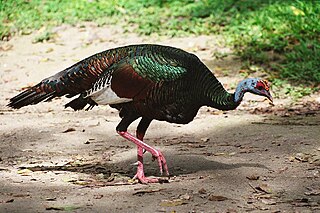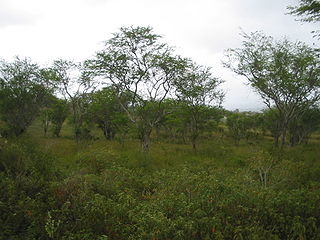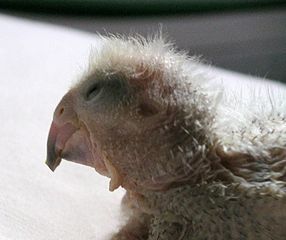Stories about the North American Wild Turkey (Meleagris gallipavo) and its domestic cousins abound as Thanksgiving approaches. And certainly this impressive and economically important bird is worthy of attention (please see articles linked below). But there is another turkey – and only one – a breathtakingly beautiful bird that is largely overlooked by zoos and private aviculturists alike. I had the good fortune of working with this species, the Ocellated Turkey (Meleagris ocellata), at the Bronx Zoo. Bringing to mind a turkey-peafowl hybrid, this fascinating bird is threatened by poaching and habitat loss, and deserves more attention from bird enthusiasts. Today I’ll take a look at its natural history and captive care.
Description
The male Ocellated Turkey’s body is clad in a mix of highly-iridescent bronze and green feathers; in the sun they are truly spectacular. The hens are a bit less-brilliant in color, but still very attractive. The blue-gray tail feathers are adorned with large, round blue and bronze spots (ocellus). The bright blue head and neck bear red and orange nodules, which are more pronounced in males.
A blue crown, which becomes larger in the breeding season, tops the male’s head; red eye rings develop at this time as well. The leg spurs, used when battling other males, are noticeably larger than those of the North American Wild Turkey (please see photo).
Somewhat smaller than their North American relative (and much smaller than barnyard versions!), males usually top out at 11-12 pounds in weight.
Range
The Ocellated Turkey is found in Mexico and Central America, where it ranges from the Yucatan Peninsula to central Belize and northern Guatemala.
Habitat
Ocellated Turkeys inhabit brushy grasslands, thorn scrub, open lowland forests, rainforest edges, riverside thickets and abandoned farms. Open habitats are utilized during the breeding season, but they never wander far from thick cover.
Diet
The natural diet appears to be as varied as is that of the North American Wild Turkey. Leaves, berries and other fruits, nuts, seeds, small snakes, lizards, spiders, worms, insects and other invertebrates are taken with equal relish. Field studies indicate that chicks subsist largely upon insects, but captive born youngsters take a wide range of foods.
From egg to adult, Ocellated Turkeys face predators ranging in size from coatis and snakes to pumas and jaguars. Consequently, they remain wary and alert even after several generations in captivity.
Ocellated Turkeys in Captivity
I kept Ocellated Turkeys in heavily planted-outdoor exhibits provisioned with heated shelters. They were somewhat high-strung and always on guard, but did fine as long as dense cover was available. I do not believe they would thrive in bare exhibits. Although some European zoos allow their turkeys outdoor access on warm winter days, those I’ve worked with seemed quite cold-sensitive and were kept indoors during the late fall and winter.
Ocellated Turkeys are not fussy eaters and readily accept commercial turkey chow, but I strove to provide a great deal of dietary variety. They especially favored the crickets, mealworms and other insects I tossed in most days, and continually searched the leaf litter for snacks at other times.
Breeding in zoos is sporadic, with more success being had in Europe, especially Belgium, than in the USA. They are rare in private collections, and remain very expensive.
Status in the Wild
Ocellated Turkeys are classified as “Near Threatened” by the IUCN and are listed on Appendix III of CITES.
They are hunted, often illegally, throughout much of their range. Males lose much of their characteristic caution during the breeding season, and make easy targets as they display in open grassy areas. Habitat loss to logging and agricultural expansion also threatens their survival.
Even in undisturbed habitats, their apparent “tastiness” to non-human predators results in significant losses. One study found that 85% of the chicks hatched in June did not survive until September; 30% of the breeding hens were taken by predators during the same time period.
The Ocellated Turkey’s stronghold appears to be in the Maya Biosphere Reserve of Guatemala and northern Belize, but detailed surveys are lacking.
Further Reading
http://en.wikipedia.org/wiki/Caatinga#mediaviewer/File:Caatinga.jpg
 That Bird Blog – Bird Care and History for Pet Birds
That Bird Blog – Bird Care and History for Pet Birds





